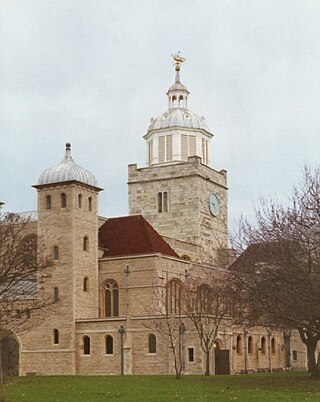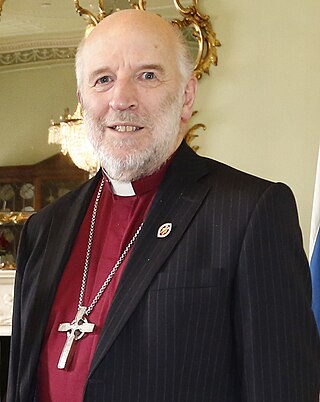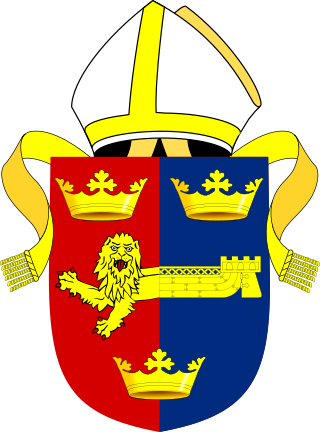
The Diocese of Monmouth is a diocese of the Church in Wales. Despite the name, its cathedral is located not in Monmouth but in Newport — Newport Cathedral, commonly known as St Woolos Cathedral. Reasons for not choosing the title of Newport included the existence of a Catholic Bishop of Newport until 1916. This apparent anomaly arose in 1921 when the diocese was created with no location for the cathedral yet chosen. Various options were being considered, such as restoring Tintern Abbey, building from scratch on Ridgeway Hill in Newport, and upgrading St Woolos, then a parish church; in the meantime the new diocese, as it covers more or less the territory of the county of Monmouth, was named the "Diocese of Monmouth". Prior to 1921 the area had been the archdeaconry of Monmouth.

The Diocese of Winchester forms part of the Province of Canterbury of the Church of England. Founded in 676, it is one of the older dioceses in England. It once covered the Kingdom of Wessex, many times its present size. Today it is most of the historic enlarged version of Hampshire.

The Diocese of Truro is a Church of England diocese in the Province of Canterbury which covers Cornwall, the Isles of Scilly and a small part of Devon. The bishop's seat is at Truro Cathedral.

The Diocese of Portsmouth is an administrative division of the Church of England Province of Canterbury in England. The diocese covers south-east Hampshire and the Isle of Wight. The see is based in the City of Portsmouth in Hampshire, where the seat is located at the Cathedral Church of St Thomas of Canterbury.

The Diocese of Gibraltar in Europe, known simply as the Diocese in Europe (DiE), is a diocese of the Church of England. It was originally formed in 1842 as the Diocese of Gibraltar. It is geographically the largest diocese of the Church of England and the largest diocese in the Anglican Communion, covering some one-sixth of the Earth's landmass. Its jurisdiction includes all of Europe, Morocco, Mongolia and the territory of the former Soviet Union.

The Diocese of Swansea and Brecon is a Diocese of the Church in Wales, established in 1923 with Brecon Priory as the cathedral. The area of the diocese had formerly been the Archdeaconry of Brecon within the Diocese of St Davids. The diocese has a border with each of the other five Welsh dioceses, as well as with the English Diocese of Hereford.

David Robert Chillingworth is an Anglican bishop. He was Bishop of St Andrews, Dunkeld and Dunblane between 2004 and 2017, until his retirement. He was also the Primus of the Scottish Episcopal Church from 2009 to 2016.

The Diocese of Sheffield is an administrative division of the Church of England, part of the Province of York.

The Diocese of Llandaff is an Anglican diocese that traces its roots to pre-Reformation times as heir of a Catholic bishopric. It is headed by the Bishop of Llandaff, whose seat is located at the Cathedral Church of Saint Peter and Saint Paul in Llandaff, a suburb of Cardiff. It currently covers most of the former Welsh county of Glamorgan, but once stretched from the River Towy to the middle of the Wye Valley.

The Diocese of Ely is a Church of England diocese in the Province of Canterbury. It is headed by the Bishop of Ely, who sits at Ely Cathedral in Ely. There is one suffragan (subordinate) bishop, the Bishop of Huntingdon. The diocese now covers the modern ceremonial county of Cambridgeshire and western Norfolk. The diocese was created in 1109 out of part of the Diocese of Lincoln.

The Diocese of Newcastle is a Church of England diocese based in Newcastle upon Tyne, covering the historic county of Northumberland, as well as the area of Alston Moor in Cumbria.

The Diocese of St Edmundsbury and Ipswich is a Church of England diocese based in Ipswich, covering Suffolk. The cathedral is St Edmundsbury Cathedral, and the bishop is the Bishop of St Edmundsbury and Ipswich. It is part of the Province of Canterbury.

The Diocese of Brechin is in the east of Scotland, and is the smallest of the seven dioceses of the Scottish Episcopal Church. It covers the historic counties of Angus and Kincardineshire. It stretches from Muchalls in the north east down to Dundee in the south, and across to Glencarse in the south west. The cathedral and administrative centre is St Paul’s Cathedral in Dundee. The diocese continues to be named after its medieval centre of Brechin.

The Diocese of Aberdeen and Orkney is one of the seven dioceses of the Scottish Episcopal Church. Created in 1865, the diocese covers the historic county of Aberdeenshire, and the Orkney and Shetland island groups. It shares with the Roman Catholic Diocese of Aberdeen a Christian heritage that can be traced back to Norman times, and incorporates the ancient Diocese of Orkney, founded in 1035.

The Diocese of Argyll and The Isles is in the west of Scotland, and is one of the seven dioceses of the Scottish Episcopal Church. It is perhaps the largest of the dioceses, but has the smallest number of church members. As a united diocese, Argyll and The Isles has two cathedrals: St John's in Oban and the Cathedral of The Isles in Millport, Isle of Cumbrae.

The Diocese of Edinburgh is one of the seven dioceses of the Scottish Episcopal Church. It covers the City of Edinburgh, the Lothians, the Borders and Falkirk. The diocesan centre is St Mary's Cathedral, Edinburgh. The Bishop of Edinburgh is the Right Revd Dr John Armes.

The Diocese of Glasgow and Galloway is one of the seven dioceses of the Scottish Episcopal Church. It covers Dumfries and Galloway, Ayrshire, Lanarkshire, Dunbartonshire, Renfrewshire and west Stirlingshire. The cathedral of the diocese is St Mary's Cathedral, Glasgow.

The Diocese of Moray, Ross and Caithness is one of the seven dioceses of the Scottish Episcopal Church. It covers Caithness and Sutherland, mainland Ross and Cromarty, and mainland Inverness-shire, Nairnshire, Moray and Banffshire. The diocesan centre is St Andrew's Cathedral in Inverness. The see is currently occupied by Mark Strange.
The Bishop of St Andrews, Dunkeld and Dunblane is the Ordinary of the Scottish Episcopal Diocese of St Andrews, Dunkeld and Dunblane. The see is located at St Ninian's Cathedral in Perth, Scotland.
Ian James Paton is a British Anglican bishop. Since 2018, he has been the Bishop of St Andrews, Dunkeld and Dunblane in the Scottish Episcopal Church.



















